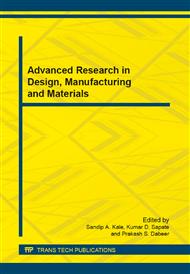p.1
p.9
p.17
p.23
p.29
p.35
p.41
p.51
Response of Starter Motor of an Engine Subjected to Random Vibrations
Abstract:
The automobile sector requires continuous progress in development of ‘Starter Motor’ by innovative approaches although significant progresses are made in the past. Development of Starter Motor has made it possible to start the engine by electrical means instead of doing it manually. The outstanding features of this motor are they can produce the maximum starting torque to crank the engine. In this case, we use electrical energy and convert it to mechanical energy in order to start the engine in motor vehicles. As the starter motor is mounted near the engine; vibrational disturbances produced due to either uneven road conditions or engine vibrations or both hampering the performance of starter motor which may result in breaking of component of motors. Vehicle will experience vibrations whose values are un-predictable at certain point of time causing random excitation and random vibrations. Aim of paper is to perform analytical formulation for Power Spectral Density function of Starter Motor by treating it as a cantilever beam and to find its response to random vibrations by using Finite Element Analysis (FEA).
Info:
Periodical:
Pages:
9-16
Citation:
Online since:
August 2014
Authors:
Price:
Сopyright:
© 2014 Trans Tech Publications Ltd. All Rights Reserved
Share:
Citation:


